Quentin Verhaegen lives on Vancouver Island in British Columbia. He describes it as “a Pacific island with a microclimate,” a place that is “more than beautiful most of the time.” He has lived there for 31 years with his wife and daughter (who’s currently working in London), but he was born in Belgium and his journey to Canada was far from linear. As Quentin puts it, his life has been “full of adventure.”
When he finished school in Belgium Quentin was required to do national service, either military service or civic service in an underdeveloped country. He chose the latter and went to be a teacher in Morocco. While he was there, he built a boat, a 50-footer (37′ on deck) with “an enormous bowsprit, telephone poles for masts, and hand-built sails.” Then, in the middle of his tenure in Morocco, he went to Bermuda to take a course in marine biology. He met a young Swedish woman doing the same course and some time later invited her to visit him in Africa. “There was a group coming to Morocco for an expedition and I asked her to join. There were supposed to be six of us, but luckily the other four canceled. Ingrid came out, went home to finish her studies, and then came back and helped me to finish the boat.”
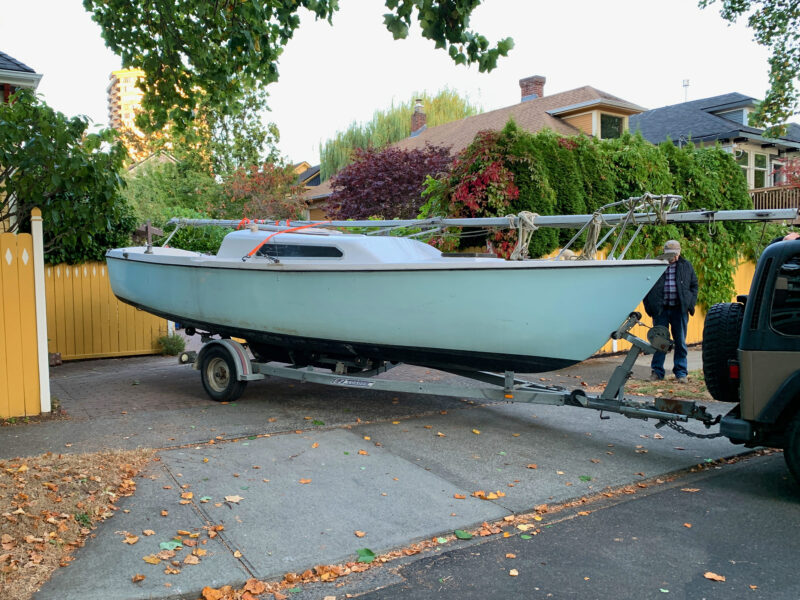 Photographs by Ingrid Holm
Photographs by Ingrid HolmThe 24’ MacGregor sloop has a partial keel—visible here just to the right of the trailer fender—which makes it easy to launch at an ordinary boat ramp. The pivoting centerboard it housed wouldn’t be needed, so Quentin fixed the board in its raised position and ’glassed over the slot.
The two adventurers left Morocco to sail the world, ending up in Australia where they sold the boat and moved ashore. Ingrid found a well-paid job that she enjoyed, and Quentin built houses. Seven years later they were off again, this time on a 47′ Bowman, a cruising sloop that they fitted out from a bare hull and deck.
They sailed for Canada because, says Quentin, “we’d decided to have a baby and that meant we had to be serious, and we thought British Columbia would be one of the best places to settle down.” They arrived 18 months later with a baby daughter and “not much else.” They sold the boat to buy a house and Quentin found work building caskets. Over the ensuing years he went through many jobs before eventually joining a small Victoria ferry company where he worked on maintaining the boats. He and Ingrid were, he says, “typical itinerant boat people.”
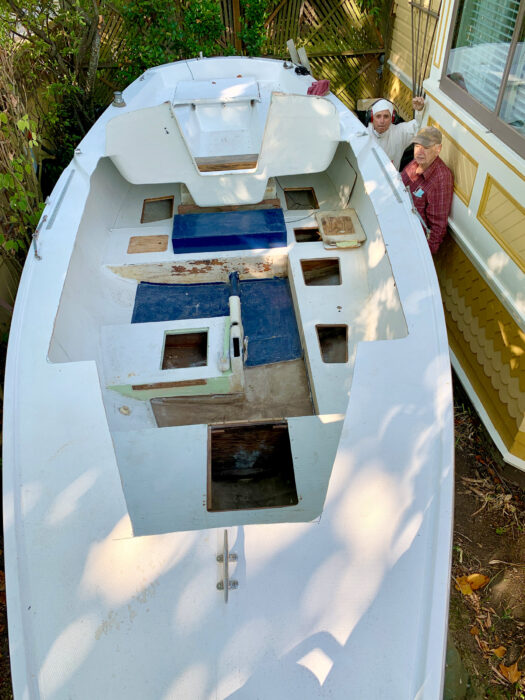
Backyard boatbuilding is often a challenge, especially when space is tight, but with most of the work being inboard and below the waterline, Quentin, here wearing white coveralls and ear protectors, would make it work.
As their daughter Kristina grew up, there was always one boat or another—always sail, never more than 27′, “just your typical inexpensive fiberglass sailboats.” But in recent years the family has been without a boat. “We missed it, though. It’s wonderful sailing here. We needed to have a boat.”
As strong as the desire to get afloat was, Quentin and Ingrid were also sure they wanted to do things differently. They love to sail but were tired of sailing into beautiful anchorages and not being able to see the view from within the cabin: “The seats are always too low, the windows too small. We wanted a motorboat, not necessarily because we didn’t want to sail, but because we wanted to wake up, sit in the cabin, have a cup of coffee, and see the beautiful land and seascape around us. We wanted it to be economical, low-maintenance, trailerable, and we wanted to be able to use it year-round in the Gulf Islands. We wanted it to have heat but not be a gas-guzzler, and because I snore loudly, Ingrid said I needed my own separate cabin.”
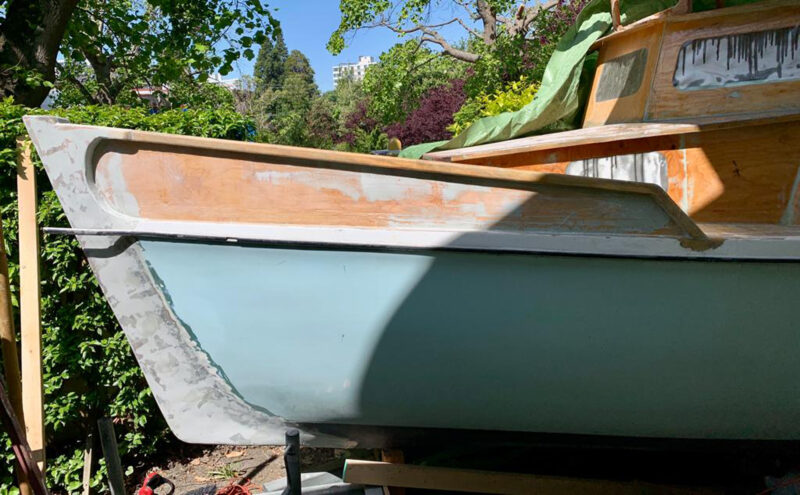
The re-purposed bow with straightened stem, sharper entry, and raised bulwark gave the boat the “motorboat/tugboat” appearance Quentin was striving for.
They started searching for the right boat at the right price. “But we couldn’t find it. Typically,” Quentin says, “old motorboats around here have a big captain’s seat with a big wheel, big engines…big everything. We didn’t want that, so we thought we’d build our own boat on a very low budget. But again, we couldn’t find anything suitable. So instead, we decided to buy an inexpensive secondhand sailboat and convert it. The problem of what to do with old fiberglass hulls is growing, and around here there’s a lot of used trailerable sailboats in reasonable condition that people just don’t want. Converting seemed like a viable alternative to building from scratch, and an affordable solution both for us and the landfill issue. But you can’t convert any old sailboat into a motorboat; it has to be the right shape.”
They settled on a 1973, 24′ MacGregor, a trailerable sloop with retractable keel and transom-hung rudder. “It was perfect,” says Quentin. “First there was the price: $1,600CAD with a trailer in late 2022. Then there was the shape: beamy, about 8′ carried well aft. The hull’s bottom is flat from amidships all the way aft…it’s the perfect combination for motoring.”
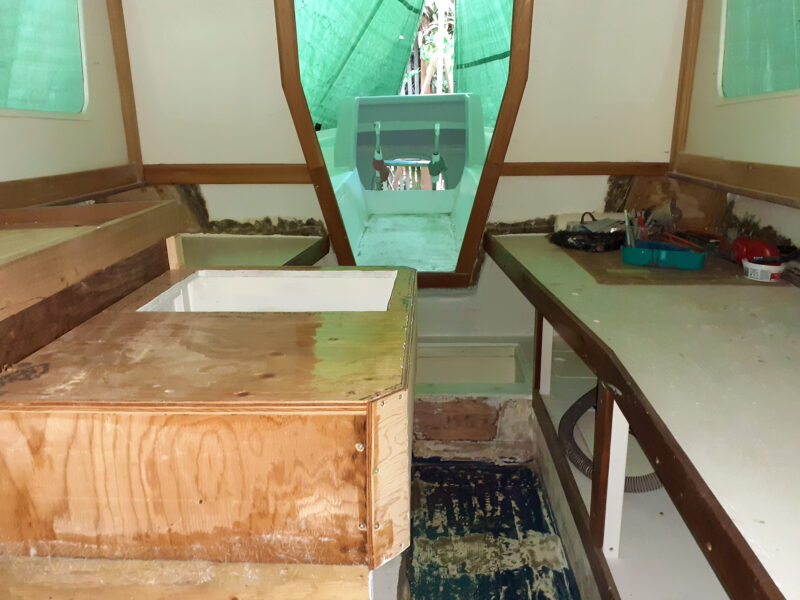
Rather than removing everything in the cabin and starting from scratch, Quentin worked with much of the original structure. He installed the settee berths along the same lines as the originals but raised them substantially to provide both storage under and good seated views through the cabin windows. He also lowered the foot of the companionway opening to reduce the “up-and-over” step when coming from the cockpit into the cabin.
Over the next 18 months, Quentin and Ingrid set about converting the MacGregor from tired sailboat to “new” motorboat in the backyard of their island home. By choice, Quentin worked alone, and for the most part stayed hidden when casual visitors came by. “If people called in to see me while I was working, I wouldn’t stop, I wouldn’t lift my head. I’d see their feet and then, after a while, they’d go away. And I didn’t go to too many people for ideas because that slows me down. I really do have all the experience I needed, but I work in an unorthodox way. I don’t cut corners, but I also don’t ask myself too many questions and get bogged down.”
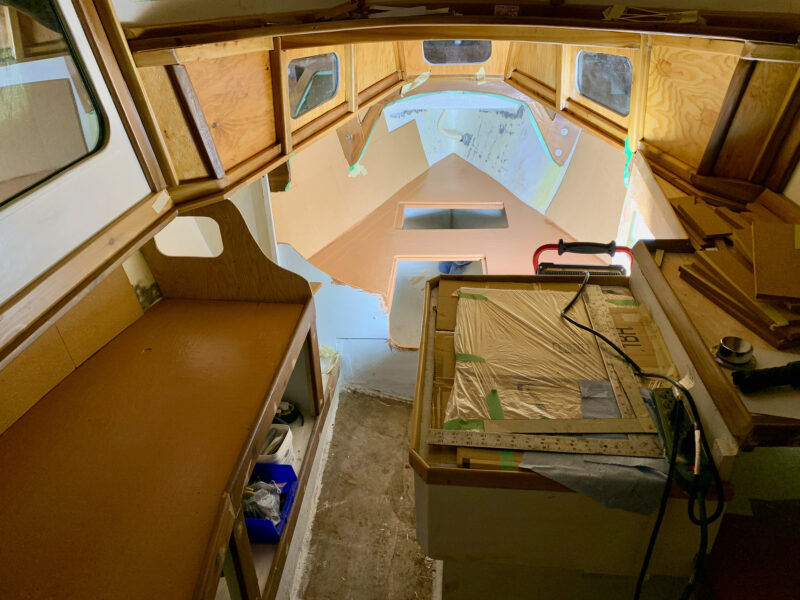
The interior quickly took shape. Quentin used construction-grade plywood, ’glassed and epoxied both inside and out, with solid cedar for framing. He chose cedar for its ease of working and light weight.
For all his solitary inclinations, Quentin has an engaging manner, a ready smile, and an infectious sense of humor. He smiles as he reveals that Ingrid is very capable of doing all the work that he did, but “she pretends she doesn’t know how. She can do fiberglass work, cut bulkheads, apply epoxy, build anything…I’ve seen her. But she’s very smart, she leaves me to get on with it. Then before I can make a mess, she jumps in to do all the finishwork.”
The project would consume 400 hours over a year and a half, working at what Quentin describes as a “retired slow pace.”
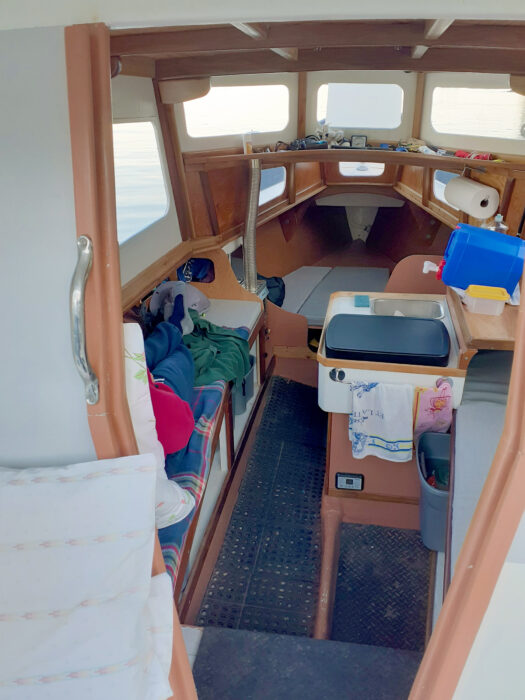
Quentin painted most of the interior plywood but varnished the cedar frame. The large windows and light colors resulted in a bright and airy cabin. Up forward is Ingrid’s master V-berth with a portable toilet under and an opening coachroof hatch above for maximum ventilation. The galley holds a simple propane stove and a small sink fed by a 10-liter jerry can with a spigot. The foot of the starboard side berth extends beneath the galley countertop.
After he got the boat home, he pulled everything out of it until he had just a bare hull. Then he chopped off the bow about 18″ back from the stem and, using solid wood and fiberglass, both inside and out, rebuilt it “motorboat/tugboat style with a high bulwark.” He set the swing keel in its raised position, which left the 18″ of fixed keel still protruding from the hull, and determining that this would be ample for tracking, he ’glassed over its slot. He added two 6′-long, 12″-deep bilge keels that would counteract any rolling and allow the boat to be beached.
From inside the hull, he filled the void between the retracted keel and the sides of the trunk with tar and then fiberglassed over the entire structure. “Tar is cheap,” Quentin says. “When it’s heated up it flows into all the gaps and fills any voids. Then, as it cools, it sets rigid so that all you have to do is ’glass over it to keep it stable.”
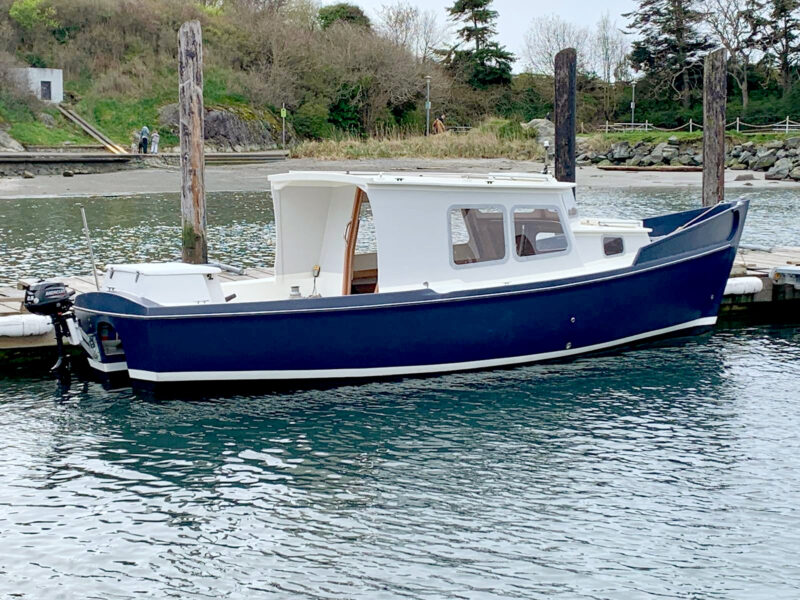
The 9.9-hp outboard is concealed within an oversized well with hinged lid to provide easy access. The motor will push the boat up to 6.5 knots. The auxiliary 2.5-hp outboard, which can push the boat at 3.5 knots at half throttle, is fixed to an articulated bracket to keep its lower unit out of the water when it’s not in use. Both outboards are operated with their tillers, so the visibility forward, says Quentin, is not great, but he wanted to keep things simple rather than add a center console with cabling. He does use a tiller extension so he can stand up on either side bench, or on the side deck, and look above or around the cabin top.
Confident that the keel and bilge keels would provide the converted hull with good directional stability, Quentin decided not to fit a skeg. “We wanted the engine low down in a well, and for the prop to stay deep so that it would not come out of the water in any seas. A skeg would simply have complicated things.”
To accommodate a new 9.9-hp four-stroke Mercury outboard, along with two 20-lb propane tanks for cooking and heating, and two 6-gallon gas tanks, Quentin converted the lazarette into a combined engine well and airtight fuel-and-propane locker. Then he turned his attention to the accommodations. In the cockpit he created two spacious storage lockers beneath side benches. One of the lockers serves as his berth. “It’s wonderful,” he says. “I have everything I need, a cozy bed, light, soundproofing, ventilation. I can sleep with the hatch open and look at the stars and listen to the wildlife, and Ingrid is in her own heaven, up forward with the heater, far away from my snoring.”
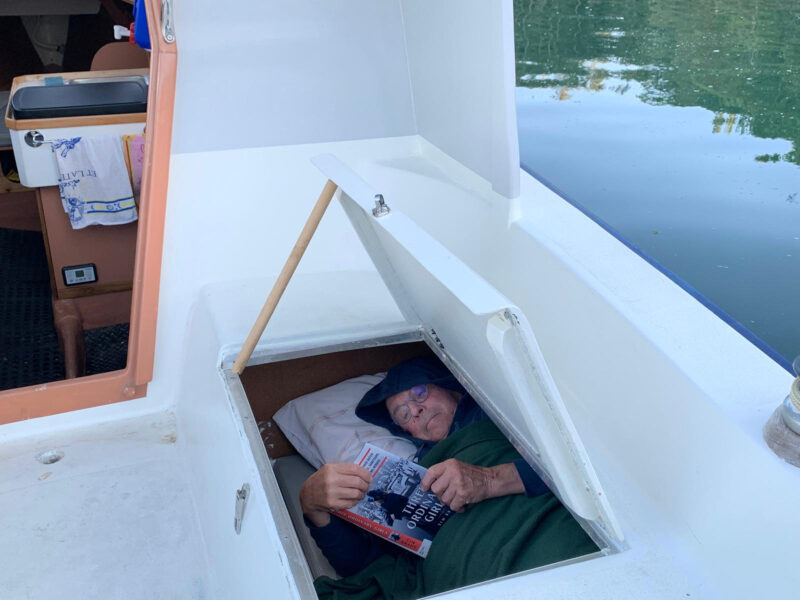
Quentin enjoys tight but comfortable quarters in the “captain’s cabin” where his snoring doesn’t bother his wife who sleeps in the V-berth in the bow. He has all he needs: a bed, light, ventilation, and an unobscured view of the night sky.
The cabin is built of 1⁄4″ construction-grade plywood with solid cedar framing. “The difference between construction-grade and marine-grade,” says Quentin, “is that it does have some voids. But if it’s used above the waterline, and well-sealed with epoxy inside and cloth and epoxy outside, it’ll last forever.”
With the exception of the captain’s quarters, the accommodations are spacious for a boat of this size. In the bow, Ingrid has a generous V-berth, while in the main cabin there are two settee berths from which “you have a full view through the large windows when you’re sitting down.” To starboard there is a two-burner gas stove and sink.
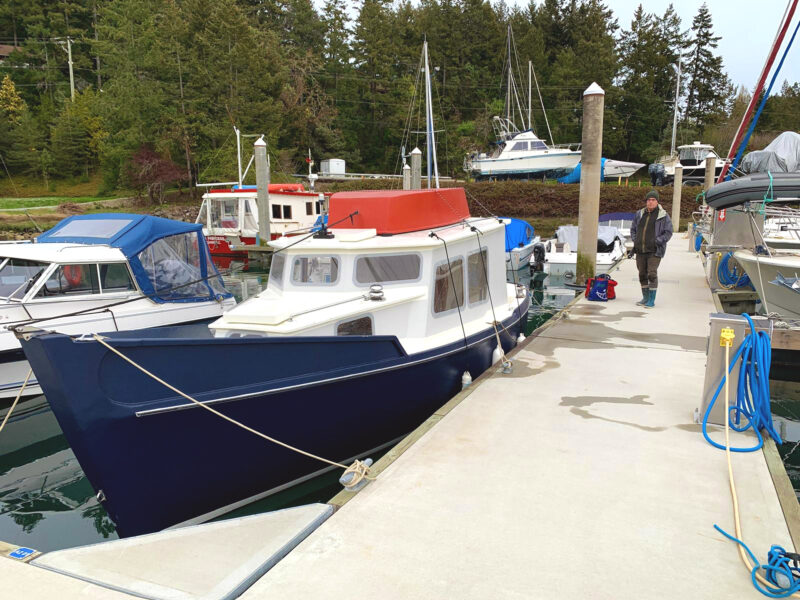
In her home slip, SCOUT looks every part the comfortable coastal-cruising motorboat. The red tender that sits atop the coachroof was designed and built by Quentin. It has a center buoyancy tank that doubles as a seat, and two rowing positions to accommodate either a lone rower or a rower with passenger. It weighs about 60 lbs and is 6’ long with a 4’ beam. When the crew doesn’t feel like rowing, the tender can use SCOUT’s 2.5-hp auxiliary outboard.
The cockpit sole is above the waterline and self-drains through a lateral pipe above the waterline. There are no other through-hulls. “There’s a Porta-Potti under the forward berth, and the water for the sink is a 10-liter jerry can with a spigot; it sits on the shelf above the sink. No through-hulls, no pumps, no hoses, no complications.”
Quentin and Ingrid launched SCOUT in early 2024 and quickly used her on eight occasions for overnight trips around islands near Victoria. “We’re very happy,” Quentin says. “We’re not familiar with motorboats, so it’s going to take us some time to get used to the maneuverability. For instance, we’re used to approaching docks and moorings slowly, leeward side, head-to-wind. Now we can turn on a dime and use reverse and increased revs. We’re learning to enjoy that power!”
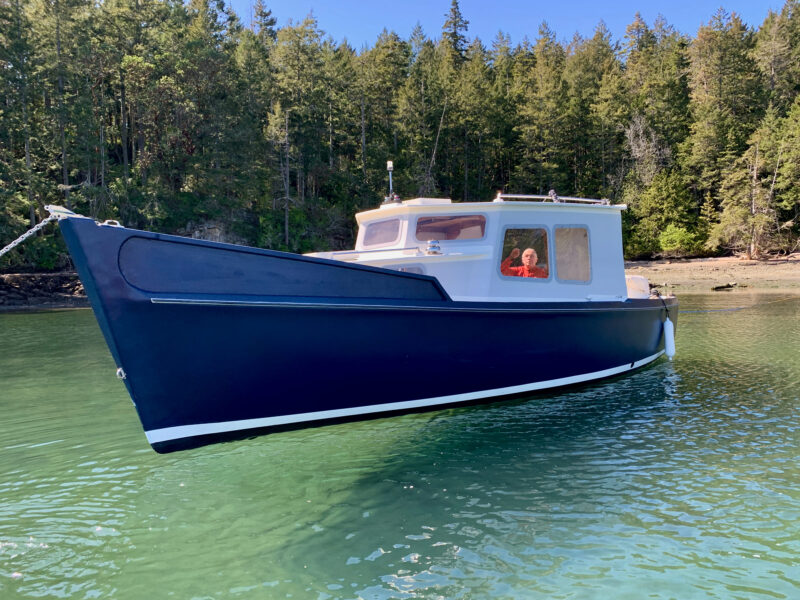
With the MacGregor’s transformation complete, there is little to suggest SCOUT’s past life as a sailboat. With her shoal draft, she can be anchored close in shore, and Quentin is looking forward to the day when they anchor off and he can wade to a beach.
With the 9.9-hp outboard they can make 6.5 knots (hull-speed) at almost-full throttle, and an easy 5.5 knots at half. While they have been cautiously sea-trialing in decent weather, the last time they went out, Quentin says there was a 20-knot wind funneling between the islands with a “fairly big chop and we did roll a bit, but not excessively, and it did well. But it’s definitely a boat designed for relatively protected, coastal waters. For example, between the cockpit and the cabin the threshold isn’t very high—I didn’t want to have to negotiate a big step up and over. So, if the cockpit were swamped by a big wave, it would swamp the whole boat.”
But Quentin and Ingrid have no desire to go ocean-voyaging. For them, the many nearby Gulf Islands hold the promise of endless days of pleasant cruising. “At half-throttle we use 1.7 liters of gas per hour. Each of our two gas tanks holds 24 liters, so we should have close to 30 hours of cruising time before we run out of gas. With all the islands to explore, we’ll go for maybe five-day trips and by then we’ll have had enough. But before that we’ll have had days of comfortable cruising, relaxing in beautiful anchorages in the warmth and shelter of the cabin, and still being able to see the amazing view. You can’t ask for better than that.”![]()
Jenny Bennett is managing editor of Small Boats.
Do you have a boat with an interesting story? Please email us. We’d like to hear about it and share it with other Small Boats readers.

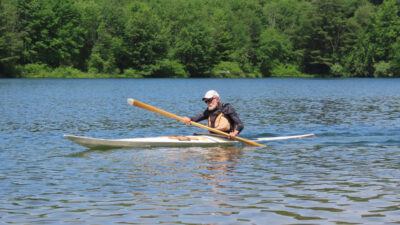
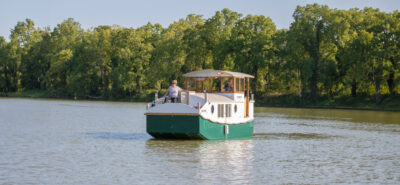
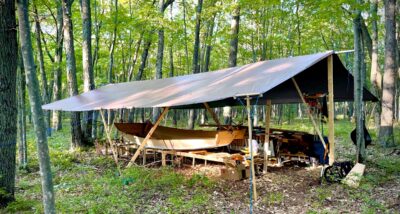
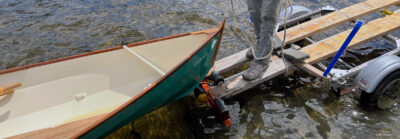
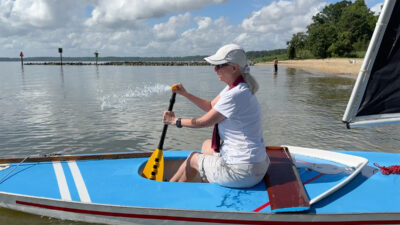
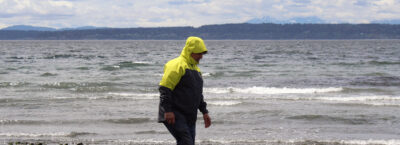
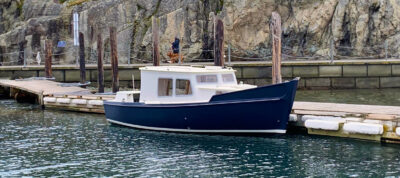
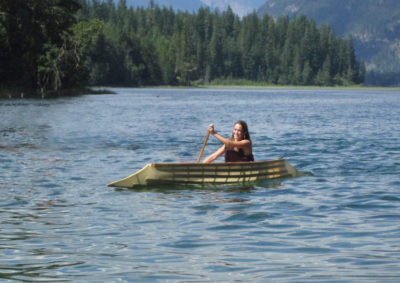
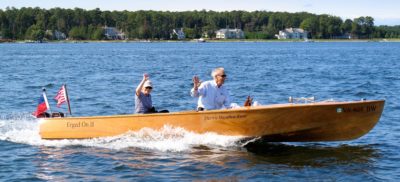
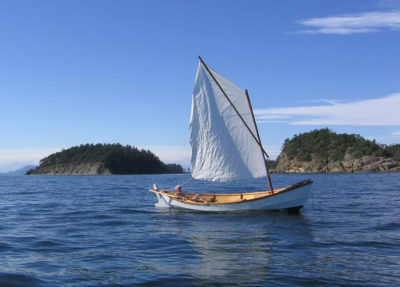
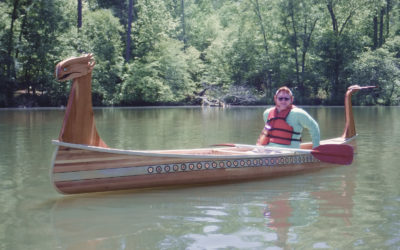
This is a great idea and practical.
Love the boat; small, simple, and economical. I want a similar setup, a small powerboat with displacement-hull speeds and a small sailing dinghy on top.
Thank you, Quentin, Ingrid, and Jenny. Fantastic job, and great article that is really inspiring, especially for showing how to re-purpose a sound sailboat hull. I haven’t even finished my little 14-foot conversion, and now I want a bigger one — with big windows like yours!
Great job, Quentin. We are in the same camp – I repurposed Independent Shipwrights’ 21’ hull. Modeled the Pilothouse after my 30’ Willard Pilothouse.
Here’s a picture. Love your choice of hull color as well
Just love your generosity to your wife Quentin…Your own snoring parlor…
Excellent idea. Sailboats make great easily driven hulls and you can find inexpensive ones to convert.
I love your boat’s style and lines. Getting it to function well and look good is not easy.
I’m currently doing something similar. I recently rescued a 1976 Balboa 26′ SK, a boat I have always wanted. After a few months of considering what to do with it, I decided to build a motorsailer. The foredeck and part of the cabin top were delaminated from water intrusion to the core, so I’ve cut it all out internally by removing the interior ceiling. It was after this operation that I decided the boat needed more headroom. I’ve removed all the stainless and teak and am now planning my new cabin top/trunk structure. The aft end is getting a transom overhaul with a drop in motorwell, with a removable enclosure and a kick-up rudder mounted on center. The plan is to redo the interior layout with a galley to starboard and keep the original placement of the dinette but add some new woodwork and cushions. I’ve removed all the old bulkheads and knees that join the cabin top to the hull. It’s still going to have a functional sail rig but shorter and with less sail area. The original swing keel is getting removed altogether in lieu of two short bilge keels and I’m filling the old SK trunk in with a slurry mixture and glassing it over to keep about the same weight. The boat should float in less than two feet of water and launched and retrieved from a flat trailer. The boat is slated to be my Great Loop cruiser, as I bought a few acres of property on Kentucky Lake, which is on the Loop. I’m planning on spending my days exploring the estuaries and tributaries in that area for the next decade or so. When I’m finished, I really want to build a Mustelid—I’m in love with that boat—but found it just as I was getting the Balboa ready for it’s trip home…so many boats and so little time.
I’ve long contemplated the same sort of conversion, but want to be able to beach, so am leery of any protruding keel. Plan is on hold for now, as I’m acquiring a Bolger Micro this summer, so anticipate sailing for a bit more time. I’ve leaned towards MacGregors, Aquarius, or Catalina 22, but am open for suggestions. Maybe someday I’ll just have to convert the Micro in spite of the keel.
Great use of an older sail boat hull. I have been thinking of the same idea. Love the look of your boat, nice job.